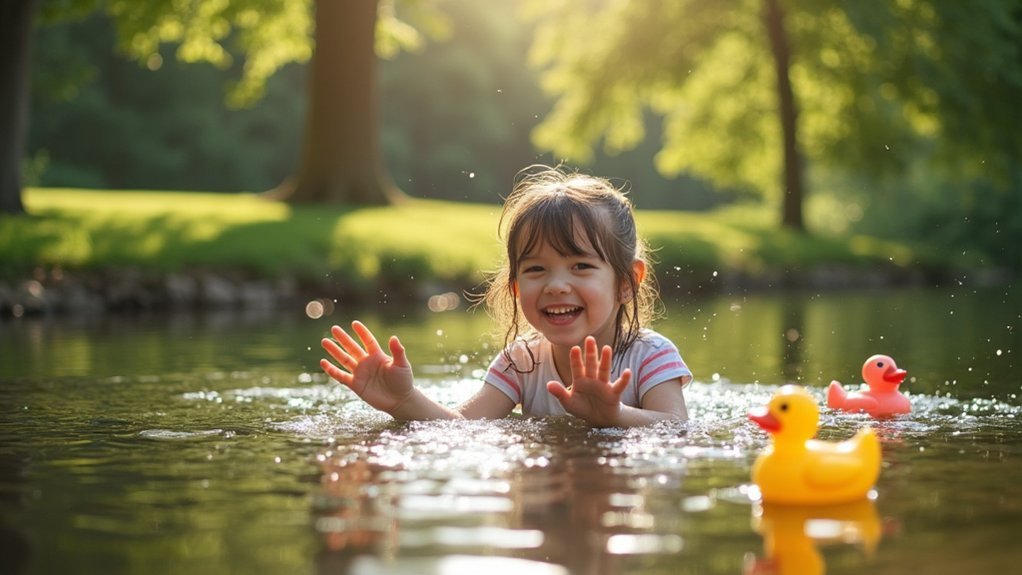Outdoor activities can provide natural sensory regulation for children with autism. Try gentle nature walks with sensory stations, therapeutic gardening, calming water play, outdoor yoga, wildlife observation, forest bathing, nature art projects, relaxing swing time, outdoor reading spaces, and stargazing. These activities reduce anxiety, improve focus, and promote emotional well-being by connecting with nature’s soothing elements. Each experience offers unique therapeutic benefits while creating moments of peace and joy in the natural world.
Gentle Nature Walks With Sensory Stations

When designed thoughtfully, gentle nature walks can transform into powerful therapeutic experiences for children with autism. Create distinct sensory stations along your route where your child can touch various leaves, stones, and bark, promoting sensory integration and fine motor skill development.
Nature creates a sensory-rich environment where children with autism can explore, discover and heal through mindful interaction.
Incorporate fragrant flowers and bubbling streams at different points to encourage sensory exploration. These natural elements reduce anxiety while enhancing emotional well-being. You’ll notice improved focus and stress reduction as your child engages with these varied sensory experiences.
Before heading out, prepare visual supports or social stories that preview each sensory station. This preparation helps your child anticipate the experiences they’ll encounter.
Remember to tailor each walk to your child’s individual needs—some may prefer quieter sounds while others might enjoy more tactile exploration.
Therapeutic Gardening and Plant Care
Select plants that engage multiple senses, such as lavender for scent, lamb’s ear for tactile stimulation, and bright sunflowers for visual appeal to create a personalized sensory garden for your child.
You’ll notice your child’s confidence grow alongside their plants as they take responsibility for watering, weeding, and nurturing their green companions.
Celebrate each growth milestone with your child—from the first sprout breaking through soil to the first bloom—reinforcing positive associations with nature and strengthening their emotional connection to the outdoor world.
Sensory Plant Selection
The right selection of sensory plants can transform a garden into a therapeutic haven for children with autism. Consider incorporating lavender, rosemary, and mint, which provide calming effects through their soothing scents, helping reduce anxiety during gardening activities.
Plants with diverse textures offer valuable tactile experiences—the soft leaves of lamb’s ear and the firm surfaces of succulents provide sensory integration opportunities that children can explore at their own pace.
Colorful flowers create visual engagement while promoting a peaceful environment.
As children water, prune, and care for these plants, they’re developing fine motor skills and building responsibility.
These shared gardening moments naturally encourage social interaction as they work together, communicate about their plants, and celebrate growth—creating meaningful connections through nature’s therapeutic elements.
Growth Milestone Celebrations
Celebrating each step in a plant’s journey provides powerful therapeutic benefits for children with autism. When you create rituals around gardening accomplishments, you’re building opportunities for emotional regulation while boosting self-esteem.
These celebrations transform simple gardening activities into meaningful developmental experiences.
Try these milestone celebration ideas:
- Create a “Growth Journal” where children can draw or photograph plants weekly, helping them process sensory experiences while documenting progress.
- Host mini-ceremonies for first sprouts, blooms, or harvests, encouraging children to describe what they see and feel.
- Design achievement badges for mastering fine motor skills like successful transplanting, proper watering, or gentle harvesting.
These celebrations don’t just acknowledge plant growth—they honor your child’s developing abilities, creating a nurturing environment where both plants and children thrive together.
Calming Water Play Experiences

Gentle ripples and cooling sensations make water play one of the most effective outdoor activities for children with autism.
You’ll find that calming water play provides a soothing sensory environment that naturally reduces anxiety while promoting relaxation. When your child splashes in a kiddie pool or explores an outdoor water table, they’re developing essential sensory processing skills through meaningful tactile stimulation.
Water’s rhythmic nature helps children self-regulate emotions, creating a peaceful space where they can process sensations at their own pace.
You’ll notice improved focus and concentration during outdoor water play as the environment naturally supports their sensory needs. Additionally, these activities create wonderful opportunities for social interactions with siblings or peers, encouraging communication in a low-pressure setting.
Consider incorporating water play into your regular routine for natural anxiety relief.
Outdoor Yoga and Mindfulness Practices
While exploring the outdoors, yoga and mindfulness practices offer children with autism a powerful combination of movement and meditation that naturally reduces anxiety.
These activities create opportunities for sensory exploration in natural settings, helping children with autism spectrum disorder (ASD) develop better emotional well-being through connection with their environment.
Sensory exploration in nature creates vital connections that nurture emotional growth for children with ASD.
You’ll notice significant benefits when incorporating these practices regularly:
- Breathing exercises paired with gentle movements improve focus and attention while teaching self-regulation techniques.
- Guided meditation in natural settings helps children process sensory information more effectively.
- Group yoga sessions foster improved social skills as children learn to observe and interact with peers in a non-threatening environment.
The natural environment provides a soothing backdrop that enhances these mindfulness practices, making them particularly effective for children with ASD.
Quiet Wildlife Observation and Bird Watching

Encouraging your child to watch birds and wildlife creates a naturally calming sensory experience that can provide relief from overstimulation and anxiety.
You’ll notice how the repetitive patterns of animal movements and behaviors offer a predictable, therapeutic rhythm that many children with autism find comforting.
Simply sitting quietly with binoculars and observing the natural world can transform a challenging day into a peaceful learning opportunity that builds focus and connection with nature.
Sensory-Calming Bird Encounters
Bird watching offers a uniquely peaceful outdoor experience for children with autism, as it combines sensory engagement with natural tranquility. The gentle movements and colorful plumage of birds provide visual stimulation without overwhelming sensory systems, helping with emotional regulation in outdoor settings.
You’ll find these approaches particularly effective:
- Set up bird feeders near windows for low-pressure observation opportunities that don’t require leaving home’s comfort zone.
- Encourage nature journaling where your child can record bird sightings, fostering both creativity and critical thinking.
- Create quiet observation routines that promote mindfulness while enhancing attention to detail.
When you introduce bird watching to your child with autism, you’re offering more than just an activity—you’re providing a gateway to nature that supports sensory processing and encourages meaningful communication through shared discovery.
Nature’s Therapeutic Patterns
When children with autism immerse themselves in nature’s organized patterns, they often experience profound calming effects that synthetic environments simply can’t replicate.
Quiet wildlife observation and bird watching serve as powerful outdoor activities that reduce stress and anxiety by engaging their minds with natural rhythms.
You’ll notice your child developing improved focus as they learn to identify different bird species and behaviors. These nature observation activities naturally encourage patience and self-regulation—skills that transfer to everyday social interactions.
The peaceful environment promotes emotional well-being while enhancing sensory processing abilities.
As your child sits quietly watching birds and wildlife, they’re experiencing a natural form of therapy that builds a deeper connection to their surroundings.
This mindful engagement with nature’s patterns provides a soothing respite that benefits both their cognitive and emotional development.
Relaxing Swing Time in Natural Settings
The gentle back-and-forth motion of a swing nestled among trees offers profound benefits for children with autism who seek sensory regulation. When you incorporate swinging into outdoor routines, you’re providing a calming sensory experience that helps reduce anxiety while strengthening vestibular processing for better balance and coordination.
The rhythmic sway of an outdoor swing creates a sanctuary where autistic children find sensory calm and vestibular harmony.
Nature’s embrace during swing time creates opportunities for:
- Emotional regulation through the rhythmic movement that soothes the nervous system
- Social interaction as children take turns or swing alongside peers in a low-pressure environment
- Unstructured play that allows natural exploration while enjoying the stress-reducing effects of outdoor settings
You’ll notice improved emotional well-being as your child connects with nature during this simple yet powerful activity, making it an essential addition to your autism support toolkit.
Sand Play Therapy and Textural Exploration
Exploring sand through therapeutic play offers children with autism a uniquely soothing sensory experience that engages their tactile system while promoting emotional regulation.
Sand play therapy helps develop fine motor skills as your child scoops, pours, and molds different structures.
You’ll notice how the contrast between dry and wet sand provides varied sensory input, allowing your child to discover preferences and gradually build tolerance to different textures. This controlled exploration can reduce anxiety in children who struggle with sensory processing challenges.
Try introducing buckets, shovels, and molds to encourage creativity while building sandcastles together. This collaborative activity not only enhances problem-solving abilities but also creates opportunities for social interaction.
The naturally calming properties of sand play promote relaxation, making it an excellent outdoor therapy option.
Cloud Watching and Sky Meditation
Gazing upward at the ever-changing sky offers children with autism a naturally calming activity that requires no special equipment or preparation.
Cloud watching promotes emotional regulation through mindfulness while enhancing creativity as children interpret shapes and patterns forming above them. This serene practice increases sensory awareness as they feel the breeze and hear nature’s sounds during their sky meditation sessions.
You can enhance this experience by:
- Bringing comfortable blankets for lying on grass while observing the clouds
- Encouraging social interaction by having children share what shapes they see
- Using cloud observations as prompts for creative storytelling or drawing activities afterward
When practiced regularly, these sky-focused activities provide a peaceful escape that helps reduce anxiety while developing important communication skills in a pressure-free natural environment.
Forest Bathing for Sensory Regulation
You’ll find remarkable sensory relief when you immerse yourself in the Japanese practice of “shinrin-yoku” or forest bathing, where the natural environment helps reduce stress hormones and promote relaxation.
Taking time to notice the textures of bark, listen to rustling leaves, and breathe in the earthy scents creates a perfect setting for sensory regulation and emotional grounding.
Try establishing a mindful connection with a specific tree during your forest visit, allowing its steady presence to anchor your thoughts and provide a calming touchpoint when sensory experiences become overwhelming.
Calming Nature Immersion
While many therapeutic approaches focus on clinical settings, forest bathing offers a profound natural alternative for children with autism. This Japanese practice, known as “Shinrin-yoku,” encourages you and your child to immerse yourselves in natural environments, which directly supports sensory regulation and emotional well-being for those with autism spectrum disorder (ASD).
Nature immersion provides three key benefits:
- Reduces cortisol levels naturally, promoting relaxation without medication.
- Creates a diverse sensory experience with natural stimuli that’s less overwhelming than urban environments.
- Improves attention span and focus through the calming effects of forest sounds and textures.
You’ll notice your child developing better coping strategies for anxiety as they engage with nature’s rhythms and patterns—a powerful complement to traditional autism therapies.
Mindful Tree Connections
A powerful extension of forest bathing involves direct, mindful connections with trees themselves. For individuals with autism spectrum disorder (ASD), these outdoor activities offer remarkable sensory regulation benefits.
When you encourage your child to touch rough bark, smell fragrant leaves, or listen to branches swaying, you’re facilitating essential sensory play that helps process environmental information.
Research confirms that these nature walks reduce cortisol levels and anxiety—common challenges in autism. The focused attention required during forest bathing improves concentration while providing a calming sensory experience.
Mindfulness emerges naturally as your child becomes absorbed in observing a tree’s details or feeling the texture of leaves.
Try guiding your child to select a “friendship tree” to visit regularly, creating a meaningful outdoor ritual that promotes emotional well-being and environmental connection.
Outdoor Art and Nature-Based Creative Expression
When children with autism engage with nature through creative expression, they often discover a powerful outlet for managing sensory needs and emotional regulation.
Outdoor art activities using ice cubes or natural materials provide calming sensory experiences while developing fine motor skills. These creative moments allow non-verbal expression of feelings, particularly beneficial for those with communication challenges.
Try these nature-based creative expressions with your child:
- Create leaf rubbings using crayons and paper placed over different textured leaves
- Craft collaborative murals with peers using twigs, stones, and other found objects
- Paint with melting ice cubes mixed with food coloring on large paper outdoors
Through these activities, you’ll foster both social skills and environmental stewardship while offering a soothing, sensory-rich experience that celebrates your child’s unique creative voice.
Peaceful Outdoor Reading Nooks
The natural world offers ideal sanctuary spaces for children with autism to immerse themselves in books away from indoor overstimulation.
Creating a peaceful outdoor reading nook beneath shade trees provides the calming effects of nature while reducing anxiety through sensory regulation.
You’ll want to incorporate soft seating, cushions, and textured blankets that enhance sensory experiences while minimizing distractions.
Consider using plants or bushes as natural barriers to create a defined space that supports routine and predictability.
Add fidget tools or sensory-friendly materials nearby so children can self-regulate while enjoying their books.
The gentle sounds of nature combined with thoughtful design elements will help your child focus more deeply on reading.
This dedicated outdoor space transforms reading from a potentially stressful activity into a soothing, enriching experience they’ll look forward to.
Stargazing and Nighttime Sensory Activities
Nighttime skies transform into perfect sensory havens for children with autism, offering a uniquely calming environment free from daytime visual overstimulation.
Stargazing provides a structured yet relaxing activity that supports emotional regulation while encouraging cognitive development through astronomical exploration.
You’ll find multiple benefits when incorporating nighttime sensory activities:
- Enhanced Communication Skills – Use the stars as conversation starters, encouraging verbal interactions through storytelling about constellations and planets.
- Sensory Processing Support – Experience the cool night breeze, cricket sounds, and visual patterns of stars to help process sensory information in a controlled setting.
- Visual Learning Opportunities – Utilize star charts or astronomy apps as visual aids that make celestial navigation accessible and engaging.
These experiences create meaningful connections with nature while providing therapeutic sensory regulation during peaceful evening hours.
Frequently Asked Questions
What Are the Best Outdoor Activities for Autistic Children?
Engage your autistic child with nature walks, gardening, scavenger hunts, water play, and unstructured outdoor exploration. These activities provide sensory stimulation, develop motor skills, and build confidence while allowing them to connect with nature.
How to Calm Overstimulation in Autism?
To calm overstimulation in autism, you’ll find relief through nature walks, creating quiet sensory breaks, using visual supports, practicing deep breathing techniques, and establishing consistent routines that provide predictability during overwhelming moments.
How to Make an Autistic Child Calm Down?
To make an autistic child calm down, you’ll need consistent routines, sensory-friendly spaces, deep pressure techniques, and visual supports. Remember their triggers, use clear communication, and provide quiet breaks when they’re overwhelmed.
What Are Leisure Activities for Autism?
Leisure activities for autism include nature walks, gardening, scavenger hunts, outdoor art projects, bubble play, sand and water play, team sports, and unstructured outdoor exploration. You’ll find these promote sensory engagement and social development.
In Summary
You’ve now discovered ten natural ways to help manage autism-related challenges. By incorporating these calming outdoor activities into your routine, you’ll create meaningful opportunities for sensory regulation, stress reduction, and joyful engagement with the natural world. Remember, nature isn’t just a backdrop—it’s a powerful therapeutic tool that’s always available. Start with what feels comfortable, and you’ll likely find your own special connection to the outdoors.





Leave a Reply